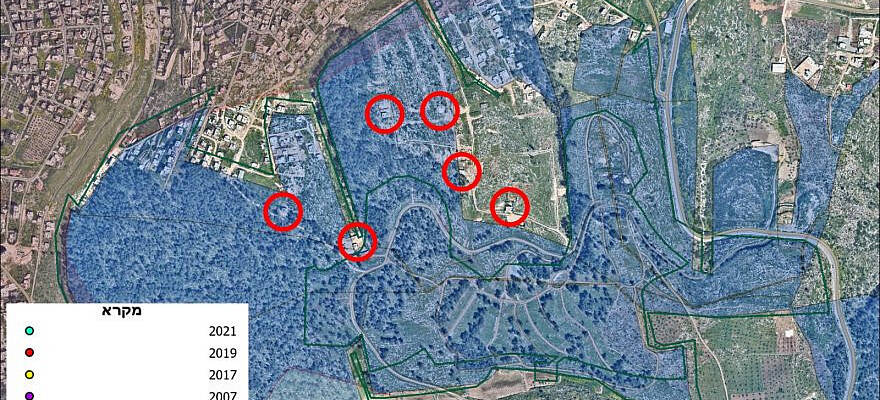Regavim documentation shows illegal Palestinian construction where Jewish communities were before the 2005 disengagement.
By JNS.org
The Israeli NGO Regavim on Sunday presented documentation to the Knesset Foreign Affairs and Defense Committee showing massive illegal Palestinian construction in Samaria, particularly where Jewish communities were located before to being evacuated as part of the 2005 disengagement plan.
During a discussion held in the context of efforts to repeal the parts of the Disengagement Law applying to northern Samaria, Avraham Binyamin, director of Regavim’s Policy Division, presented aerial photographs to the committee showing thousands of illegal Arab structures in Area C, the portion of Judea and Samaria under full Israeli jurisdiction.
He noted that these illegal structures have created a land bridge between blocs of Palestinian Authority-controlled towns and villages in Area B, thereby undermining the Oslo framework that left the question of territorial contiguity for a negotiated resolution.
“The 2005 Disengagement Law is one more element abetting the creation of a terrorist state in the heart of the Land of Israel,” said Binyamin. “The land on which the de-populated Jewish communities of northern Samaria—Ganim, Kadim, Sa-Nur [and Homesh]—once stood, has been overtaken by illegal Arab construction, despite the fact that the IDF ostensibly retains [security] control of the territory.”
“By emptying the northern Samaria communities of their Jewish residents, the Disengagement Law opened the door for Palestinian Authority annexation of the territory which the Civil Administration has done absolutely nothing to prevent,” he added.
The Knesset approved on Wednesday in first reading a bill to abolish the Disengagement Law, which led to the destruction and evacuation of four Jewish communities in northern Samaria—Sa-Nur, Homesh, Ganim and Kadim—and 21 in the Gaza Strip.
The present bill would restore freedom of movement to Israelis in the area of the four Samaria communities.
A game of cat and mouse has taken place between the IDF and former residents and supporters since the disengagement, particularly at Homesh, where a yeshiva has operated inside caravans and tents. Troops have dismantled the yeshiva several times over the years.
The coalition agreement between Likud and the Religious Zionism Party, led by Minister of Finance Bezalel Smotrich, requires the government to reverse parts of the disengagement and allow for the Homesh Yeshiva to remain as a first step towards rebuilding the four communities.
The legislation does not apply to Gaza, from which all Jews were removed in 2005.
“The false prophecies of the architects of the ‘disengagement,’ who claimed that ceding territory would enhance Israel’s security, continue to blow up in our faces,” said Meir Deutsch, director general of Regavim. “Precisely because there is no longer a Jewish presence on the ground, there is no security. The borders of the State of Israel are being re-drawn by the Palestinian Authority—without negotiation, without compromise, in ways that threaten the security of the entire State of Israel. It is long past time to reverse this disastrous policy.”
